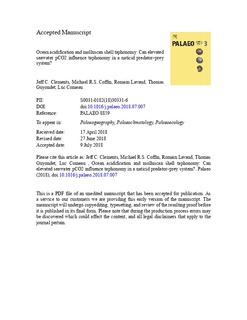| dc.contributor.author | Clements, Jeff C. | |
| dc.contributor.author | Coffin, Michael RS | |
| dc.contributor.author | Lavaud, Romain | |
| dc.contributor.author | Guyondet, Thomas L. | |
| dc.contributor.author | Comeau, Luc André | |
| dc.date.accessioned | 2019-05-03T06:56:48Z | |
| dc.date.available | 2019-05-03T06:56:48Z | |
| dc.date.created | 2019-01-25T14:19:08Z | |
| dc.date.issued | 2018 | |
| dc.identifier.citation | Palaeogeography, Palaeoclimatology, Palaeoecology. 2018, 507 145-154. | nb_NO |
| dc.identifier.issn | 0031-0182 | |
| dc.identifier.uri | http://hdl.handle.net/11250/2596387 | |
| dc.description.abstract | The size and frequency of gastropod drill holes in shells of their prey are common indicators of predator-prey ecology in the fossil record. Taphonomic processes occurring after predation, however, can influence the preservation of shells in a given fossil assemblage and can thus influence ecological inferences based on preserved shells. To determine if ocean acidification (OA) has the capacity to influence prey shell taphonomy in a gastropod drilling predation system, we tested for effects of elevated pCO2 on dissolution rates, breakage force, and drill hole diameters in non-fragmented shells of two prey species of the cannibalistic naticid gastropod, Euspira heros. Drilled and non-drilled shells of Littorina littorea and E. heros were exposed to control (~300 μatm) and elevated (~800 and 4000 μatm) pCO2 treatments for five weeks. Dry shell weight and drill hole diameter (outer and inner) were recorded for individual shells before and after exposure; the force required for shell breakage was recorded at the end of the exposure period. Shell mass loss in 800 and 4000 μatm, respectively, were ~1 and 7% for E. heros, and ~0 and 4% for L. littorea, compared to ~0% in the control for both species. Shell breakage force was unaffected by elevated pCO2, but was affected by species and drill hole presence, with E. heros shells requiring a force of ~220 and 269 Newtons in drilled and non-drilled shells, respectively, compared to ~294 and 415 Newtons in L. littorea. At 4000 μatm, outer drill hole diameter significantly increased by ~12% for E. heros, while inner drill hole diameter significantly increased by ~13% in E. heros and ~10% in L. littorea. Ultimately, this study provides the first documentation of molluscan shell taphonomy in the context of OA for a gastropod drilling predation system and sets the stage for future research. | nb_NO |
| dc.language.iso | eng | nb_NO |
| dc.publisher | Elsevier | nb_NO |
| dc.rights | Attribution-NonCommercial-NoDerivatives 4.0 Internasjonal | * |
| dc.rights.uri | http://creativecommons.org/licenses/by-nc-nd/4.0/deed.no | * |
| dc.title | Ocean acidification and molluscan shell taphonomy: Can elevated seawater pCO2 influence taphonomy in a naticid predator–prey system? | nb_NO |
| dc.type | Journal article | nb_NO |
| dc.type | Peer reviewed | nb_NO |
| dc.description.version | acceptedVersion | nb_NO |
| dc.source.pagenumber | 145-154 | nb_NO |
| dc.source.volume | 507 | nb_NO |
| dc.source.journal | Palaeogeography, Palaeoclimatology, Palaeoecology | nb_NO |
| dc.identifier.doi | 10.1016/j.palaeo.2018.07.007 | |
| dc.identifier.cristin | 1665191 | |
| dc.description.localcode | © 2018. This is the authors’ accepted and refereed manuscript to the article. Locked until 17 July 2020 due to copyright restrictions. This manuscript version is made available under the CC-BY-NC-ND 4.0 license http://creativecommons.org/licenses/by-nc-nd/4.0/ | nb_NO |
| cristin.unitcode | 194,66,10,0 | |
| cristin.unitname | Institutt for biologi | |
| cristin.ispublished | true | |
| cristin.fulltext | preprint | |
| cristin.qualitycode | 2 | |

